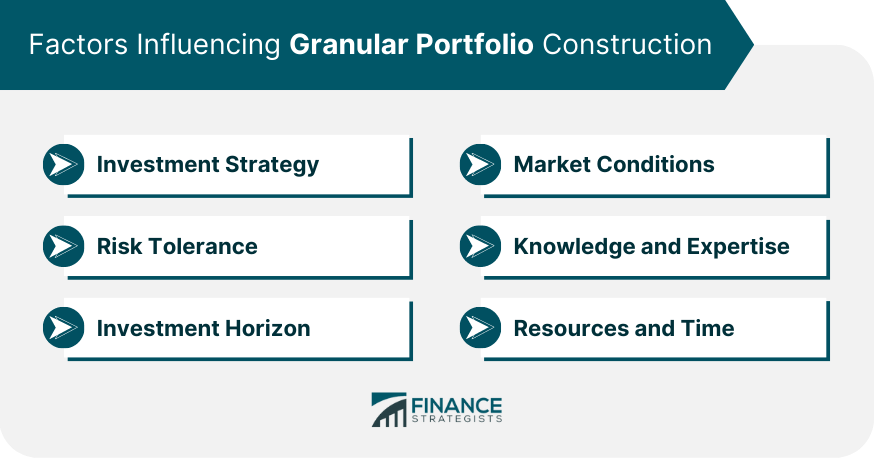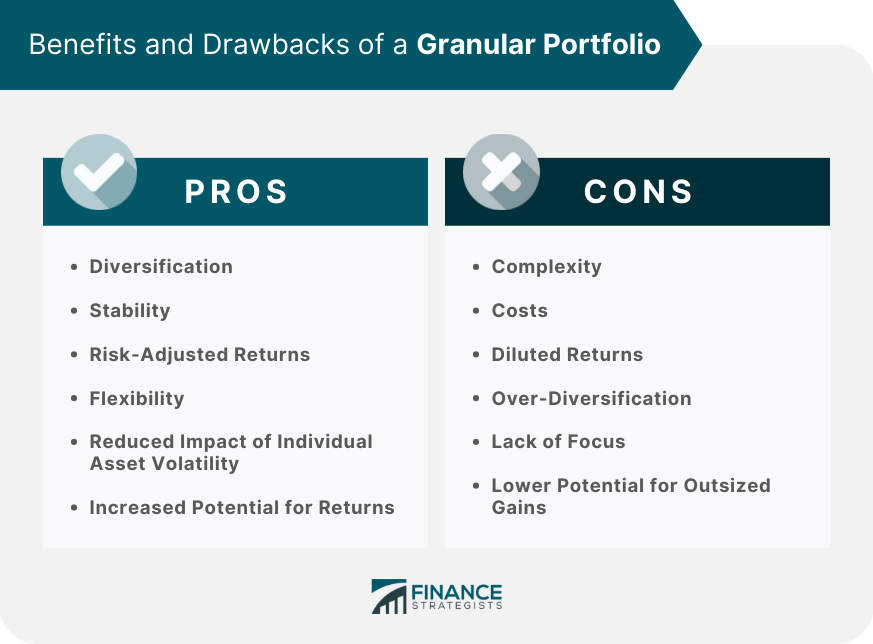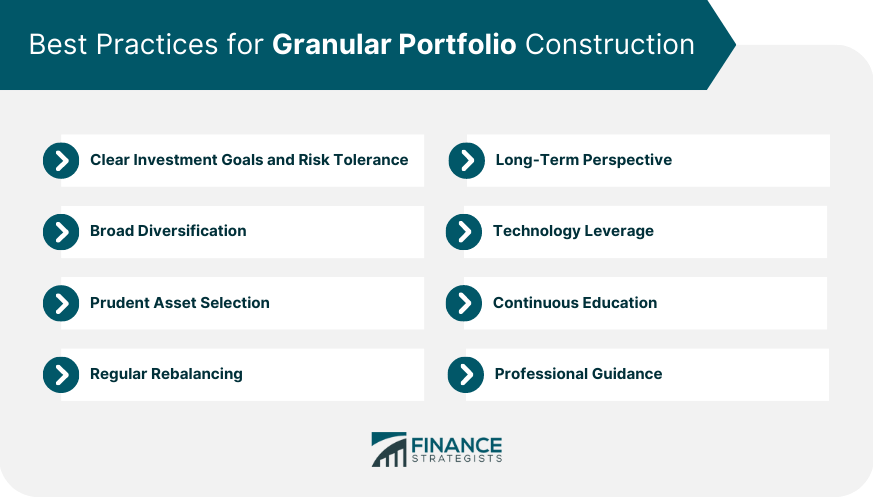A granular portfolio is an investment strategy that involves diversifying investments across a broad spectrum of assets. In this strategy, a portfolio comprises a large number of distinct assets, with each individual asset making up a relatively small percentage of the total investments. The intention behind such diversification is to spread the risk across multiple assets, sectors, or asset classes. The term "granular" in this context refers to the fine-level detail, analogous to grains in a larger substance. In a granular portfolio, the risk is spread over many "grains" or individual investments, reducing the potential impact of any single investment underperforming or failing. The granular approach to portfolio construction can be contrasted with a concentrated approach, where a portfolio is heavily weighted towards a small number of investments. While a concentrated portfolio can offer high returns if the selected investments perform well, it can also lead to significant losses if these investments perform poorly. On the other hand, a granular portfolio tends to provide more stable and consistent returns, albeit possibly at the expense of high short-term gains. Granularity in finance is the degree to which a portfolio is diversified. A highly granular portfolio comprises many different assets, with each making up a small portion of the overall portfolio. The primary aim of a granular portfolio is to spread the risk and avoid the concentration of risk in a few investments. According to the Modern Portfolio Theory (MPT), a granular portfolio can offer an optimal risk-return tradeoff by balancing investments across uncorrelated assets. The practical implication of a granular portfolio is that it requires a robust and comprehensive investment strategy. Investors must analyze a large number of assets, track their performance, and rebalance the portfolio as necessary. This necessitates a high level of financial knowledge and a robust investment management system. However, the benefits can be significant as a granular portfolio can provide stable returns while minimizing risk. This is the framework that guides the selection of assets in a granular portfolio. An investment strategy typically outlines the types of investments to include, their target allocations, the timing for purchases and sales, and the conditions that would trigger a rebalancing of the portfolio. The strategy should be aligned with the investor's goals, risk tolerance, and investment horizon. For instance, if an investor is aiming for steady long-term growth with moderate risk, their strategy might involve a mixture of growth stocks, bonds, and potentially some alternative investments like real estate or commodities. This refers to the degree of uncertainty or potential financial loss an investor is willing to take on in pursuit of profit. Risk tolerance varies significantly among individuals and influences the granularity of the portfolio. A conservative investor with low risk tolerance may opt for a highly granular portfolio with a large number of low-risk assets. On the other hand, an aggressive investor with high risk tolerance may choose fewer, higher-risk assets, resulting in a less granular portfolio. It is essential for the portfolio to align with the investor's risk tolerance level to ensure comfort and commitment to the chosen investment approach. The investment horizon refers to the length of time an investor plans to hold investments before selling them. Short-term investors might focus on assets that can provide quick returns, while long-term investors might opt for assets that offer stable, long-term growth. A granular portfolio might be more suitable for long-term investors as it can help to manage the risks associated with market volatility over extended periods. The current and anticipated conditions in the financial markets also influence the construction of a granular portfolio. These conditions could include macroeconomic indicators, such as GDP growth rates, inflation, and interest rates, as well as market-specific trends and indicators. For instance, in a bull market, an investor might choose to be less granular and more concentrated in equities, while in a bear or volatile market, the investor might prefer a more granular approach to spread the risk across a wide array of securities. Granular portfolio construction requires a broad understanding of different asset classes, sectors, and individual securities. This is because, with a larger number of assets in the portfolio, the investor needs to be able to analyze and monitor a wide range of investments. Granular portfolio construction and management can be time-consuming and resource-intensive. Monitoring a large number of investments and rebalancing the portfolio as needed requires a significant time commitment. Therefore, the investor's available resources, both in terms of time and potentially cost (e.g., transaction fees), will influence the degree of granularity in their portfolio. The most significant advantage of a granular portfolio is diversification. By holding a large number of different assets, investors can spread the risk associated with their investments. If one or several assets underperform or fail, the impact on the overall portfolio is mitigated because each individual asset represents only a small fraction of the total investments. Due to its diversified nature, a granular portfolio tends to offer more stability compared to a concentrated portfolio. While the returns from individual assets may fluctuate, the overall performance of a granular portfolio can be relatively steady, as the different assets' returns balance each other out over time. By spreading investments across a wide array of assets, investors can potentially achieve a good balance between risk and return. They may not hit the highest highs when a particular asset class performs exceptionally well, but they also won't suffer the lowest lows when an asset class performs poorly. Granular portfolios offer the flexibility to include a wide range of assets. This can be advantageous as it allows investors to take advantage of different opportunities that arise in various sectors, asset classes, or geographic regions. In a granular portfolio, the volatility of a single investment has a lesser effect on the portfolio's total value. This can be particularly advantageous during periods of market uncertainty or turbulence. A granular portfolio increases exposure to more performing assets. While some investments may perform poorly, others within the portfolio might perform exceptionally well, ensuring that the portfolio's overall performance remains robust. Due to the larger number of assets, granular portfolios can be complex to manage. Monitoring performance, rebalancing, and staying updated about the fundamentals of each individual investment can be time-consuming and require a considerable amount of knowledge and expertise. Trading costs can be higher in granular portfolios due to the increased number of transactions. Every time an asset is bought or sold, transaction fees can apply, which can eat into the portfolio's returns, especially if the portfolio is frequently rebalanced. While diversification reduces risk, it can also potentially dilute returns. If a small number of assets in the portfolio have high returns, their impact may be diluted by the presence of other, lower-performing assets. This contrasts with a concentrated portfolio, which can have high returns if its limited number of investments perform well. There is also a risk of over-diversification, which occurs when a portfolio becomes so spread out that it essentially mirrors the market. In such cases, the investor may be better off investing in a low-cost index fund. A granular portfolio may lack focus compared to a concentrated portfolio. Concentrated portfolios allow investors to pick a handful of assets they believe in strongly and focus their resources there, while granular portfolios spread investments across a wide array of assets. Because investments are spread across a wide array of assets, a granular portfolio may not realize the outsized gains from a winning bet in a concentrated portfolio. A clear understanding of your financial goals, risk tolerance, and investment time horizon is vital to building a successful granular portfolio. Your portfolio should reflect these parameters and adjust as they change over time. The core principle of granular portfolio construction is diversification. Diversify across asset classes, sectors, geographies, and even investment styles. By spreading investments widely, you minimize the risk of substantial losses from any single investment. Choose your assets wisely. Research each potential investment thoroughly, looking at factors like historical performance, future prospects, risk level, and how it correlates with other assets in your portfolio. Over time, some investments may outperform others, causing your portfolio to drift from its original asset allocation. Regular rebalancing brings your portfolio back in line with your investment goals and risk tolerance. However, be mindful of potential tax implications and transaction fees that might come with frequent rebalancing. Investing should typically be a long-term endeavor, particularly when building a granular portfolio. While some assets will have short-term fluctuations, the goal of a granular portfolio is to grow steadily over time. Avoid the temptation to overreact to short-term market movements. There are many tools and platforms available today that can help with granular portfolio construction and management. Robo-advisors, for instance, can build a diversified portfolio based on your risk tolerance and investment goals, and automatically rebalance it as needed. The investment landscape is dynamic and constantly evolving. Continuous learning about new investment opportunities, strategies, and market trends can help you make informed decisions and adjust your portfolio as needed. If you're not comfortable constructing and managing a granular portfolio on your own, consider working with a financial advisor. A professional can provide valuable guidance tailored to your unique financial situation and goals. A granular portfolio offers a strategic approach to investment diversification. By spreading investments across a large number of assets, each constituting a small fraction of the total portfolio, investors can effectively manage risk and pursue steady, long-term growth. The stability offered by a granular portfolio can serve as a valuable buffer against market volatility, helping to smooth out returns over time. The strategy requires careful consideration of multiple factors, such as risk tolerance, investment goals, and market conditions, and may be most suited to investors with a long-term horizon and a moderate risk appetite. However, as with any investment strategy, it comes with its own set of challenges. The management of a granular portfolio requires a deep understanding of various asset classes and a substantial commitment of time and resources. Increased transaction costs and the potential for over-diversification are among the key considerations when adopting this strategy. Nevertheless, with prudent selection of assets, regular rebalancing, broad diversification, and, importantly, a long-term perspective, a granular portfolio can provide a balanced risk-return profile for investors. As with any investment, continuous education and professional guidance are essential components of success.What Is a Granular Portfolio?
The Concept of Granularity in Finance
Theoretical Framework
Practical Implications
Factors Influencing Granular Portfolio Construction
Investment Strategy
Risk Tolerance
Investment Horizon
Market Conditions
Knowledge and Expertise
Resources and Time

Benefits of a Granular Portfolio
Diversification
Stability
Risk-Adjusted Returns
Flexibility
Reduced Impact of Individual Asset Volatility
Increased Potential for Returns
Drawbacks of a Granular Portfolio
Complexity
Costs
Diluted Returns
Over-Diversification
Lack of Focus
Lower Potential for Outsized Gains

Best Practices for Granular Portfolio Construction
Clear Investment Goals and Risk Tolerance
Broad Diversification
Prudent Asset Selection
Regular Rebalancing
Long-Term Perspective
Technology Leverage
Continuous Education
Professional Guidance

Final Thoughts
Granular Portfolio FAQs
A granular portfolio is an investment strategy that involves diversifying investments across a wide array of assets. The portfolio comprises a large number of distinct assets, each making up a relatively small percentage of the total. The intention is to spread risk across multiple assets, sectors, or asset classes, reducing the potential impact of any single investment underperforming or failing.
The main benefits of a granular portfolio include diversification, stability, risk-adjusted returns, flexibility, reduced impact of individual asset volatility, and increased potential for returns. By diversifying across a large number of assets, a granular portfolio can minimize the potential losses from any single investment.
While a granular portfolio offers several advantages, it also comes with potential drawbacks. These include the complexity of managing a large number of investments, higher transaction costs due to increased trading, potentially diluted returns, a risk of over-diversification, lack of focus, and potentially lower chances for outsized gains.
Constructing a granular portfolio involves defining clear investment goals and risk tolerance, diversifying widely across asset classes, sectors, and geographies, selecting assets prudently, regularly rebalancing the portfolio, maintaining a long-term perspective, leveraging technology, continuously educating oneself about investment trends, and potentially seeking professional guidance.
The main difference between a granular and concentrated portfolio lies in their diversification approach. A granular portfolio includes a large number of distinct assets, each making up a small portion of the total investments. This approach spreads risk across multiple assets. In contrast, a concentrated portfolio is heavily weighted towards a small number of investments. While this can lead to high returns if these investments perform well, it also carries the risk of significant losses if they perform poorly.
True Tamplin is a published author, public speaker, CEO of UpDigital, and founder of Finance Strategists.
True is a Certified Educator in Personal Finance (CEPF®), author of The Handy Financial Ratios Guide, a member of the Society for Advancing Business Editing and Writing, contributes to his financial education site, Finance Strategists, and has spoken to various financial communities such as the CFA Institute, as well as university students like his Alma mater, Biola University, where he received a bachelor of science in business and data analytics.
To learn more about True, visit his personal website or view his author profiles on Amazon, Nasdaq and Forbes.















